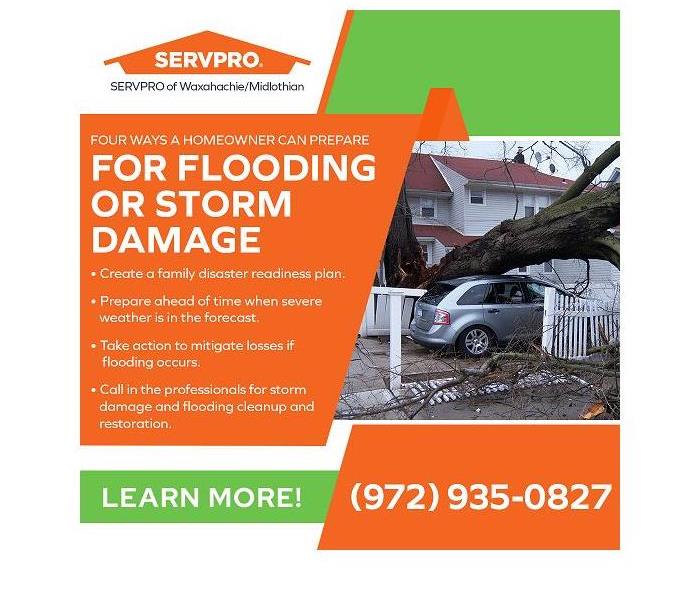Why Homeowners Need to Have the Proper Flood Insurance before Severe Weather Strikes
3/7/2022 (Permalink)
Blog Summary: SERVPRO of Waxahachie/Midlothian urges homeowners and business owners to have adequate flood insurance before a storm damage disaster occurs.
The cost of flood damage restoration without homeowners insurance or adequate flood insurance can be financially devastating. Structural damage to the roof and the resulting water damage can cost tens of thousands of dollars to repair. Most typical homeowners policies cover this type of storm damage. However, flood damage from a localized flash flood or a micro flood may be exempt from a homeowners policy, and the homeowner may not have been required to have FEMA flood insurance. The time to find out which coverage is needed is before, not after, a disaster.
In advance of the Atlantic hurricane season, homeowners and businesses are urged to review their insurance coverage situation. Efforts to recover from a flood with no or inadequate insurance coverage can be expensive.
The cause of storm damage may be related to wind or water. In either case, the homeowner with insufficient coverage will realize that recovery is difficult, painful, and may not be financially feasible. Some property owners are lulled into thinking adequate coverage is too expensive and not essential. How often does a “hundred-year flood” occur? Once is enough to cause devastation.
Localized Flooding: A Growing Problem
A rise in temperatures and humidity levels in the atmosphere produce intense storms. When these storm cells stall or linger over a community, massive amounts of water are dumped onto roads, parking lots, and neighborhoods that lack the drainage infrastructure to manage the torrential rains. The increased frequency of these isolated yet powerful storm cells is causing flooding in small neighborhoods, large planned residential communities, and municipalities that previously were unaffected.
Most homeowners have a typical homeowners insurance policy. However, the standard policy usually has a hurricane deductible and does not cover flooding. These two features can be financially catastrophic when flooding is the cause of the property damage.
An insurance policy covering flooding is a separate policy and can be obtained through the National Flood Insurance Program. Some private carriers offer flood coverage. Lenders typically do not require flood insurance unless the property is located in a specially designated flood zone.
Help for the Uninsured
Some assistance from government programs might be available for uninsured homeowners who have suffered flood-related damage. FEMA grants and Small Business Administration loans might be available to some homeowners. However, this aid is not guaranteed. The funds, if available, will likely not be sufficient to repair all the damages. The weather event must be declared a disaster area for both FEMA and the SBA to get involved. Homeowners can apply for SBA loans approaching $200,000 but only on the primary residence. Repayment of the loan is in addition to the mortgage payment, which continues even though the structure may be uninhabitable. A bank or other private lending institution may offer a home equity or construction loan for the rebuild.
Four Ways a Homeowner Can Prepare for Flooding or Storm Damage
Here are a few practical tips to help homeowners prepare for and respond to severe weather conditions that might result in flood damage and storm damage.
1. Create a family disaster readiness plan.
This plan includes:
- Basic first aid supplies, medications, and vital prescriptions
- Basic survival food and equipment such as flashlights, batteries, weather band radios, walkie talkies, matches, candles, water filters, and water
- Critical data in hand and on the cloud
- Pre-qualification of a reputable property damage restoration company specializing in storm damage, flood restoration, water damage, fire and smoke damage, and mold remediation
2. Prepare ahead of time when severe weather is in the forecast.
Place lawn furniture, toys, garbage cans, and any gardening equipment in a secure location. Close the garage door.
3. Take action to mitigate losses if flooding occurs.
Safety must never be compromised. Relocate furniture, artwork, electronic equipment, computers, and other valuables to a second floor or to a location in the home that is less likely to be inundated by rising waters.
4. Call in the professionals for storm damage and flood cleanup and restoration.
Delays allow for advanced secondary damage to take place. Swollen baseboards, warping in floors and drywall, and mold infestation can be avoided when bulk water is quickly removed. Dehumidification and applied structural drying can prevent further damage and speed up the timeline to recovery.
SERVPRO of Waxahachie/Midlothian has been serving the area since 2000. Being centrally located in Ellis County means they are within a thirty-minute drive or less of any location in the community. This rapid response is crucial in a property damage disaster involving a water intrusion from flooding, storm damage, or a burst supply pipe.
To learn more information about storm damage cleanup in Red Oak, TX, contact the office of SERVPRO of Waxahachie/Midlothian by phone at (972) 935-0827 or by email at acarey@SERVPRO10932.com



 24/7 Emergency Service
24/7 Emergency Service
